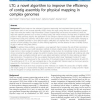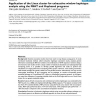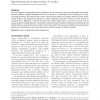61 search results - page 8 / 13 » A Study on Clustering Method by Self-Organizing Map and Info... |
BMCBI
2010
13 years 4 months ago
2010
Background: Physical maps are the substrate of genome sequencing and map-based cloning and their construction relies on the accurate assembly of BAC clones into large contigs that...
ALMOB
2008
13 years 7 months ago
2008
Background: One of the goals of global metabolomic analysis is to identify metabolic markers that are hidden within a large background of data originating from high-throughput ana...
BMCBI
2007
13 years 7 months ago
2007
Background: With the popularisation of high-throughput techniques, the need for procedures that help in the biological interpretation of results has increased enormously. Recently...
BMCBI
2008
13 years 7 months ago
2008
Background: Genetic association studies have been used to map disease-causing genes. A newly introduced statistical method, called exhaustive haplotype association study, analyzes...
BIB
2008
13 years 7 months ago
2008
For most organisms, computational operon predictions are the only source of genome-wide operon information. Operon prediction methods described in literature are based on (a combi...



